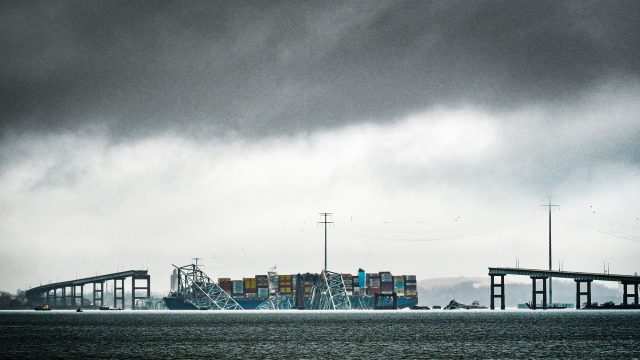
It’s been less than a week since the Dali, a massive cargo ship nearly the size of the Empire State Building, struck a support pillar on Baltimore’s Francis Scott Key Bridge, triggering a massive and deadly structural collapse. It has become one of the worst infrastructure disasters in recent American history. Six construction workers who had been filling potholes on the bridge at the time of its collapse are believed dead as divers on Wednesday switched from “rescue” operations to a grimmer “salvage” effort. Above all else, this is a fundamentally human tragedy.
At the same time, the bridge disaster’s material impact is significant and urgent. Some estimates for the cost of rebuilding the structure hover near $2 billion, even as government officials and industry experts grapple with the “potential impacts on regional and national supply chains” caused by the Port of Baltimore’s temporary closure, the White House said on Thursday morning.
“I’ve directed my team to move heaven and Earth to reopen the port and rebuild the bridge as soon as humanly possible,” President Biden says on the bridge collapse.”It is my intention that the federal government will pay for the entire cost of reconstructing that bridge.” pic.twitter.com/9DoIru2AsGMarch 26, 2024
While President Joe Biden has stressed that he intends for the federal government to cover the “entire cost of reconstructing that bridge,” the financial fallout from this disaster extends far beyond the mere cost of rebuilding. Even if Biden can follow through on his pledge to foot the reconstruction bill, industry analysts are bracing for billions of dollars in insurance claims stemming from the disaster, with liability still up in the air. It seems virtually certain that there will, at some point, be a new bridge in Baltimore, but the accompanying financial questions are decidedly more complex.
What did the commentators say?
The fight over who will cover the damages caused by the bridge collapse could take years. It will likely be “one of the most contentious marine insurance cases in recent decades,” said Fordham University’s Lawrence Brennan to The Wall Street Journal. Grace Ocean, the Singaporean company that owns the Dali, is likely to “invoke a law dating back to the 19th century that limits the liability of ships’ owners” similar to the one used by the owners of the Titanic after that ship’s infamous maritime disaster.
Reinsurers are “set to bear the bulk of the claim amid concerns it could become the largest ever marine loss,” industry publication Reinsurance News said. Some 80 different reinsurance firms are covering around $3 billion for Grace Ocean’s direct insurance, Moody’s analyst Brandan Holmes told the outlet. While the total sum is expected to be enormous, it’s “unlikely to be a significant event for individual carriers as it will be spread across so many players.” Insurers are nevertheless scrambling to assess their liability and losses “across several product lines including property, cargo, marine, liability, trade credit and contingent business interruption,” Reuters said. Given how unclear the extent of the damage is, and the timeline for possible restitution, it’s likely “still too early to give a reliable estimate” on what the final price tag for the insurance industry will be, Financial Times said.
For the government, Biden’s goal to cover the reconstruction costs with federal dollars likely means “further action from Congress will be needed,” Roll Call said. With multiple projects vying for the estimated $1 billion in available emergency funds, several Maryland lawmakers have begun lobbying to release more money as soon as possible, and are “expecting the emergency funding legislation to be bipartisan.” Without specific details or plans for a new bridge at this stage, however, a spokesperson for Maryland Gov. Wes Moore (D) said in a statement to USA Today that the expectation is the rebuilding process will simply be “long and expensive.”
What next?
Biden’s pledge to move “heaven and earth” to begin the reconstruction process notwithstanding, simply cleaning up the disaster site to assess how best to begin construction will likely take weeks, Bipartisan Policy Center infrastructure and disaster analyst Andy Winkler said to Time. While Biden himself will likely be the beneficiary (or victim) of that pledge, the reality is that “our federal system incidents like this require more of a partnership between local state and federal officials” than one man’s promises.
Politicians, legal experts, and the insurance industry are all grappling with the financial fallout of America’s worst infrastructure tragedy in years






